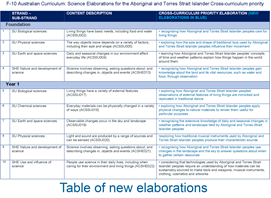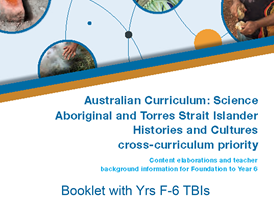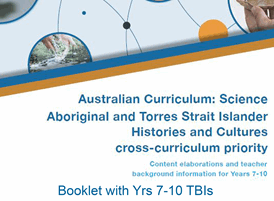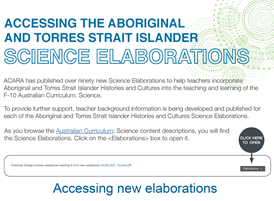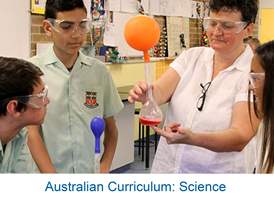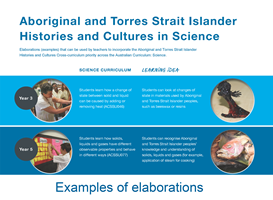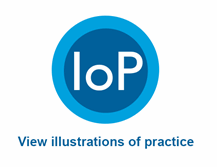Overview
The Australian Curriculum sets consistent national standards to improve learning outcomes for all young Australians. ACARA acknowledges the gap in learning outcomes between Aboriginal and Torres Strait Islander students and their non-Indigenous peers. It recognises the need for the Australian Curriculum to provide every opportunity possible to ‘close the gap’.
Therefore, the Australian Curriculum is working towards addressing two distinct needs in Aboriginal and Torres Strait Islander education:
- that Aboriginal and Torres Strait Islander students are able to see themselves, their identities and their cultures reflected in the curriculum of each of the learning areas, can fully participate in the curriculum and can build their self-esteem
- that the Aboriginal and Torres Strait Islander Histories and Cultures cross-curriculum priority is designed for all students to engage in reconciliation, respect and recognition of the world’s oldest continuous living cultures.
New Science elaborations addressing Aboriginal and Torres Strait Islander Histories and Cultures
In response to feedback from community and educators, ACARA has developed 95 new elaborations with accompanying teacher background information to help teachers to incorporate the Aboriginal and Torres Strait Islander Histories and Cultures cross-curriculum priority in the Australian Curriculum: Science.
These elaborations were developed with the assistance of ACARA's Aboriginal and Torres Strait Islander Advisory Group and Taskforce, and Science and Aboriginal and Torres Strait Islander curriculum specialists, and provide practical examples across all three strands of the science curriculum and all year levels.
The elaborations acknowledge that Aboriginal Peoples and Torres Strait Islander Peoples have worked scientifically for millennia and continue to contribute to contemporary science. They are scientifically rigorous, demonstrating how Indigenous history, culture, knowledge and understanding can be incorporated into teaching core scientific concepts.
Each elaboration is accompanied by teacher background information that explains in detail the cultural and historical significance of the chosen topic and how it connects to the core science curriculum content. It also includes a list of consulted works, provided as evidence of the research undertaken to inform the development of the teacher background information. The teacher background information is accessible through the Aboriginal and Torres Strait Islander Histories and Cultures icon appearing next to the elaboration.
The elaborations and accompanying teacher background information support teachers in providing a more culturally responsive curriculum experience for Aboriginal and Torres Strait Islander students resulting in increased engagement and better educational outcomes. They also provide an opportunity for teachers to engage all students in respect and recognition of the world's oldest continuous living cultures.
Aboriginal and Torres Strait Islander Histories and Cultures
The Aboriginal and Torres Strait Islander Histories and Cultures priority provides opportunities for all students to deepen their knowledge of Australia by engaging with the world’s oldest continuous living cultures. Through the Australian Curriculum, students will understand that contemporary Aboriginal and Torres Strait Islander communities are strong, resilient, rich and diverse.
The Aboriginal and Torres Strait Islander Histories and Cultures priority uses a conceptual framework to provide a context for learning. The framework comprises the underlying elements of Identity and Living Communities and the key concepts of Country/Place, Culture and People. Aboriginal and Torres Strait Islander Identities are represented as central to the priority and are approached through knowledge and understanding of the interconnected elements of Country/Place, Culture and People. The development of knowledge about Aboriginal and Torres Strait Islander Peoples’ law, languages, dialects and literacies is approached through the exploration of Cultures. These relationships are linked to the deep knowledge traditions and holistic world views of Aboriginal communities and/or Torres Strait Islander communities.
Students will understand that Identities and Cultures have been, and are, a source of strength and resilience for Aboriginal Peoples and Torres Strait Islander Peoples against the historic and contemporary impacts of colonisation.
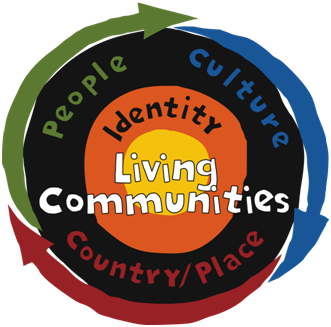
Figure1: Conceptual framework for the Aboriginal and Torres Strait Islander Histories and Cultures priority
Key ideas
Key concepts
The first key concept of the organising ideas highlights the special connection to Country/Place by Aboriginal and Torres Strait Islander Peoples and celebrates the unique belief systems that connect people physically and spiritually to Country/Place.
The second concept examines the diversity of Aboriginal and Torres Strait Islander Peoples’ culture through language, ways of life and experiences as expressed through historical, social and political lenses. It gives students opportunities to gain a deeper understanding of Aboriginal and Torres Strait Islander Peoples’ ways of being, knowing, thinking and doing.
The third concept addresses the diversity of Aboriginal and Torres Strait Islander societies. It examines kinship structures and the significant contributions of Aboriginal and Torres Strait Islander Peoples on a local, national and global scale.
Organising ideas
For each cross-curriculum priority, a set of organising ideas reflects the essential knowledge, understandings and skills for the priority. The organising ideas are embedded in the content descriptions and elaborations of each learning area as appropriate.
| Code | Organising ideas |
|---|---|
| Country/Place | |
| OI.1 | Australia has two distinct Indigenous groups: Aboriginal Peoples and Torres Strait Islander Peoples, and within those groups there is significant diversity. |
| OI.2 | Aboriginal and Torres Strait Islander communities maintain a special connection to and responsibility for Country/Place. |
| OI.3 | Aboriginal and Torres Strait Islander Peoples have holistic belief systems and are spiritually and intellectually connected to the land, sea, sky and waterways. |
| Culture | |
| OI.4 | Aboriginal and Torres Strait Islander societies have many Language Groups. |
| OI.5 | Aboriginal and Torres Strait Islander Peoples’ ways of life are uniquely expressed through ways of being, knowing, thinking and doing. |
| OI.6 | Aboriginal and Torres Strait Islander Peoples live in Australia as first peoples of Country or Place and demonstrate resilience in responding to historic and contemporary impacts of colonisation. |
| People | |
| OI.7 | The broader Aboriginal and Torres Strait Islander societies encompass a diversity of nations across Australia. |
| OI.8 | Aboriginal and Torres Strait Islander Peoples' family and kinship structures are strong and sophisticated. |
| OI.9 | The significant contributions of Aboriginal Peoples and Torres Strait Islander Peoples in the present and past are acknowledged locally, nationally and globally. |
Learning Areas
Learning areas statements
All Australian Curriculum learning areas can contribute to the Aboriginal and Torres Strait Islander Histories and Cultures cross-curriculum priority. Taken collectively, Australian Curriculum learning areas deepen students’ knowledge and understanding of Australia and the First Australians. This knowledge and understanding enriches all students’ ability to participate positively in the ongoing development of Australia.
Aboriginal and Torres Strait Islander Histories and Cultures are included in each learning area in ways that are consistent with its content and purpose. They also make it possible to link content across learning areas, which can lead to integrated units of work.
Each learning area contributes differently to the Aboriginal and Torres Strait Islander Histories and Cultures cross-curriculum priority and its key concepts of Country/Place, Culture and People. Australian Curriculum content descriptions and elaborations relating specifically to Aboriginal and Torres Strait Islander Histories and Cultures are tagged with the priority symbol. In other content descriptions and elaborations, the cross-curriculum priority can be inferred from the use of the terms ‘Identity’, ‘Country/Place’, ‘Culture’, and ‘Peoples’.
Learning areas value Aboriginal and Torres Strait Islander Histories and Cultures. Each one articulates appropriate and relevant aspects of the priority and how it can be incorporated in the curriculum.
English
In the Australian Curriculum: English, students begin to engage with the priority as they develop an awareness and appreciation of, and respect for, Aboriginal and Torres Strait Islander literature. This includes storytelling traditions (oral narrative) and contemporary literature. Students will learn to develop respectful, critical understandings of the social, historical and cultural contexts associated with different uses of language features and text structures including images and visual language.
Mathematics
Students can explore connections between representations of number and pattern and how they relate to aspects of counting and relationships of Aboriginal and Torres Strait Islander cultures. Students can investigate time, place, relationships and measurement concepts within Aboriginal and Torres Strait Islander contexts. Through the application and evaluation of statistical data, students can deepen their understanding of the lives of Aboriginal and Torres Strait Islander Peoples.
Science
Students will have opportunities to learn that Aboriginal and Torres Strait Islander Peoples have longstanding scientific knowledge traditions and developed knowledge about the world by:
- observation, using all the senses
- prediction and hypothesis
- testing (trial and error)
- making generalisations within specific contexts such as the use of food, natural materials, navigation and sustainability of the environment.
Humanities and Social Sciences
The diverse cultures of Aboriginal and Torres Strait Islander Peoples are explored through their:
- long and continuous strong connections with Country/Place and their economic, cultural, spiritual and aesthetic value of place, including the idea of custodial responsibility. Students examine the influence of Aboriginal and Torres Strait Islander Peoples on the environmental characteristics of Australian places, and the different ways in which places are represented.
- experiences before, during and after European colonisation including the nature of contact with other peoples, and their progress towards recognition and equality. In particular, students investigate the status and rights of Aboriginal and Torres Strait Islander Peoples, past and present, including civic movements for change, the contribution of Aboriginal and Torres Strait Islander Peoples to Australian society, and contemporary issues.
- exploration of how groups express their particular identities, and come to understand how group belonging influences perceptions of others.
The use of primary and secondary sources, including oral histories, gives students opportunities to see events through multiple perspectives, and to empathise and ethically consider the investigation, preservation and conservation of sites of significance to Aboriginal and Torres Strait Islander Peoples.
The Arts
Students’ exploration of traditional and contemporary artworks by Aboriginal and Torres Strait Islander Peoples provides insight into the way the relationships between People, Culture and Country/Place for Aboriginal and Torres Strait Islander Peoples can be conveyed through the arts, their expression in living communities, and the way these build Identity.
Technologies
Students will identify the interconnectedness between technologies and Identity, People, Culture and Country/Place. They will explore, understand and analyse how this intrinsic link guides Aboriginal and Torres Strait Islander Peoples in sustaining environments, histories, cultures and identities through / by creating appropriate and sustainable solutions.
Health and Physical Education
This learning area allows students to appreciate and celebrate the beauty of the world’s oldest continuous living cultures. Students will be able to explore personal, community and group identities and so build understanding of the differences and commonalities in systems of knowledge and beliefs about Health and Physical Education. There is the capacity for making strong connections between cultures and identities and to engage with and appreciate the lived experiences of Aboriginal and Torres Strait Islander Peoples. Students can learn about the richness of Aboriginal and Torres Strait Islander modes of communication and ways of living and being, and develop appreciation and understanding of uniquely Australian connections between People and Country/Place. They can explore the importance of family and kinship structures for maintaining and promoting health, safety and wellbeing within their community and the wider community. Students can also be given the opportunity to participate in physical activities and cultural practices such as traditional and contemporary Aboriginal and Torres Strait Islander games.
Languages
The Framework for Aboriginal Languages and Torres Strait Islander Languages provides a direct way of learning about and engaging with diverse Aboriginal and Torres Strait Islander communities. Aboriginal and Torres Strait Islander Histories and Cultures are an integral part of learning Aboriginal languages and Torres Strait Islander languages as there is an inseparable connection between the languages and land, sea, sky and waterways. Through learning a framework language, all students gain access to knowledge and understanding of Australia that can only come from an Aboriginal or Torres Strait Islander perspective.
For Aboriginal and Torres Strait Islander students, learning their own language can have a significant influence on their overall learning and achievements. It can foster a strong sense of identity, pride and self-esteem and enables students to develop a wider recognition and understanding of their culture, Country/Place and People. This then contributes to their wellbeing.
In all other language learning, there is scope for making interlinguistic and intercultural comparisons across languages to develop understanding of concepts related to the linguistic landscape of Australia and to the concepts of language and culture in general.
Work Studies
The exploration of concepts of self-identity provide opportunities to develop understanding of the distinctive sense of identity of Aboriginal and Torres Strait Islander Peoples. This can lead to an understanding of how identity is strongly linked to Aboriginal and Torres Strait Islander Peoples’ unique belief systems and their spiritual connection to the land, sea, sky and waterways. The curriculum can demonstrate the influence these have on relationships within the world of work through the Australian Curriculum: Work Studies.
